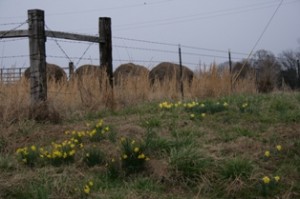There were patches of these daffs blooming in Mississippi this weekend all along Highway 32 between I-55 and my home town, Charleston, MS. They even come up through kudzu to bloom! I also saw N. x odorus (Campernelle), Jetfire, and other unknown cultivars. What fun to jump ahead into spring by traveling south. I was back home after dark tonight, so I'm not sure what else is in bloom here now.
Earlier I had noted my season was one week in advance of last year. It seems a couple of years ago I saw all these species in bloom in MS. on my way back from the Central Mississippi Daffodil Society's show in Ridgeland which is still several weeks off. Is everyone here and farther south way ahead of schedule? Larry Force, I wish I'd had time to stop by your place to see what you had in bloom!
It was raining and in the 50's today. We have 20's F at night coming in a day or so.
Becky
that daffy girl near Nashville, TN


Becky
Could you please tell those of us this side of the water who allegedly invented the language what kudzu is?
There were patches of these daffs blooming inMississippi Charleston , MS
http://en.wikipedia.org/wiki/Kudzu
Kudzu (クズ or 葛, Kuzu?), Pueraria lobata (syn. P. montana, P. thunbergiana), (sometimes known as foot a night vine, mile a minute vine, Gat Gun, Ge Gan[1] and < I>The vine that ate the South) is one of about 20 species in the genus Pueraria in the pea family Fabaceae, subfamily Faboideae. It is native to southern Japan and southeast China in eastern Asia. The name comes from the Japanese word for this plant, kuzu. The other species of Pueraria occur in southeast Asia, further south.
Kudzu was introduced from Japan into the United States in 1876 at the Philadelphia Centennial Exposition, where it was promoted as a forage crop and an ornamental plant. From 1935 to the early 1950s the Soil Conservation Service encouraged farmers in the Southeastern United States to plant kudzu to reduce soil erosion as above, and the Civilian Conservation Corps planted it widely for many years.
Kudzu growing on shrubs
However, it was subsequently discovered that the Southeastern US has near-perfect conditions for kudzu to grow out of control ― hot, humid summers, frequent rainfall, temperate winters with few hard freezes (kudzu cannot tolerate low freezing temperatures that bring the frost line down through its entire root system, a rare occurrence in this region), and no natural predators. As such, the once-promoted plant was named a pest weed by the United States Department of Agriculture in 1953.
Infestation of Kudzu in the United States.
Kudzu is now common throughout most of the Southeastern United States, and has been found as far northeast as Paterson, New Jersey, in 30 Illinois counties including as far north as Evanston,[12] and as far south as Key West, Florida.[citation needed] It has also been found growing (rather i nexplicably) in Clackamas County, Oregon in 2000.[13] Kudzu has naturalized into about 20,000 to 30,000 square kilometers (7,700